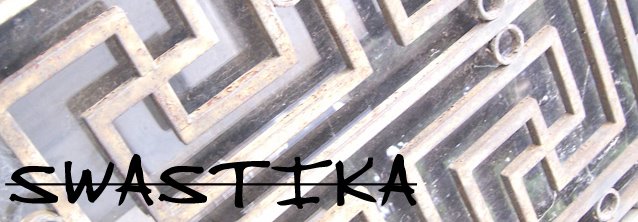Haley says about his foto:
Hector
"... At the time this horse was carved, the swastika still had the positive symbolism that it has had for over 3,000 years. Long before the Nazi's distorted it, the swastika was used by cultures around the world to symbolize prosperity, power, strength and good luck. It has been found in ancient Greece, especially at Troy, and was widely used in China, Persia, Japan, India, Europe and North and South America.
The word 'swastika' comes from ancient Sanskrit - 'su', meaning 'well', and 'asti', meaning 'being'. Not until the mid-1930s, well after this carousel horse was carved, did the swastika take on a negative connotation. (Until 1933, the American 45th Infantry Division used the swastika on its shoulder patches.) The Nazi part adopted the swastika in 1919 as the symbol of their organization and only with the rise of Hitler's power did the symbol take on a negative meaning. The Allies banned the symbol from Germany in 1945 after Germany's defeat in World War II.
Shortly after the end of the war this design on Hector was removed and forgotten. It wasn't until 1995 during the carousel restoration project that the symbol was rediscovered and restored to its original design. Although the designs on Hector find their inspiration in Native American art, the swastika caused a negative public reaction and the decision was made to remove Hector from the carousel permanently. Ironically, the reason that keeps Hector from riding the magnificent carousel he once called home is also the reason that makes him so speical - he is definitely one of a kind. Some suggest that Hector may one day find a place within the Smithsonian Museum in Washington D.C..." [Jantzen Beach SuperStore, 2006]
skip to main |
skip to sidebar
Idea of this blog
The Swastika is a symbol that belongs too the entire human race they appear in many different forms and in almost all our ancestral cultures, exsisting for more than 15.000 years with different names.It was and always will be a symbol of protection and good luck.
Unfortunately during the second world war the nazi's were effective in there misuse of the symbol , from that moment on it belonged to intolerance ,hatred and fear and has a bad image even in present day and in many countries it is a symbol forbidden too use, altough the nazi swastika is a black cross in 45 degrees pointing to the right on white with a red background, most of all the other swastikas are postive and there's no reason to connect this to the genocide.
This is a space which we try too recuperate and share the positive swastika and its meaning as a part of cultural heritage too humanity, here in the blog are more than thousand examples.
I like to share with you, Everyday a new foto of a Swastika. The beautifull Swastika wich is used in daily life:
As decoration
In Art
As in Ritual
In Body
I would like that You share also with everybody your Swastikas. So if you make a Photo from your Swastikaobject or art and send me this i gonna publish it here.
Send Photos to Swastikamail swastikacross@gmail.com
I like to share with you, Everyday a new foto of a Swastika. The beautifull Swastika wich is used in daily life:
As decoration
In Art
As in Ritual
In Body
I would like that You share also with everybody your Swastikas. So if you make a Photo from your Swastikaobject or art and send me this i gonna publish it here.
Send Photos to Swastikamail swastikacross@gmail.com
Free stuff
Labels
- Tattoo (736)
- City (522)
- Household (398)
- Art (312)
- Architecture (278)
- Info (272)
- Clothes (261)
- Drawing (225)
- Design (189)
- Ritual (180)
- Jewellery (178)
- Temple (163)
- Education (106)
- Human (104)
- travel (104)
- Food (92)
- Manwoman (71)
- Books (65)
- Good Luck (56)
- Scarification (55)
- Nature (52)
- Swastika Freakshop (31)
- Festival Cobh Cork (30)
- Music (30)
- Video (30)
- Knitting (28)
- Cemetery (26)
- Learn to Love the Swastika (22)
- Carlsberg brewery (13)
- Branding (12)
- Wallpaper (10)
- Implant (9)
- Interview (9)
- Merchandising (8)
- My Swastika (5)
- Hopi (1)
More Swastika Info
Friends of the Swastika
Swastika
Tsil no'oli
Sunwheel
Cha.Lee.Poh
چلیپا
Hakakross
Banji
St Bridget's Cross
Gammadion
Winkelmaßkreuz
만자
Tetraskelion
Cosmos cross
σβάστικα
Svastika
Lauburu
الصليب المعقوف
Hakenkruis
Fylfot
Cвастика
เครื่องหมายนาซี
Cruz gamada
Manji
Horogkereszt
צלב הקרס
Swastyka
Croix gammée
Hakaristi
གཡུང་དྲུང་།
Xac
Chữ Vạn
まんじgamalı haç
Crosh Cuirn
Haakrist


No comments:
Post a Comment